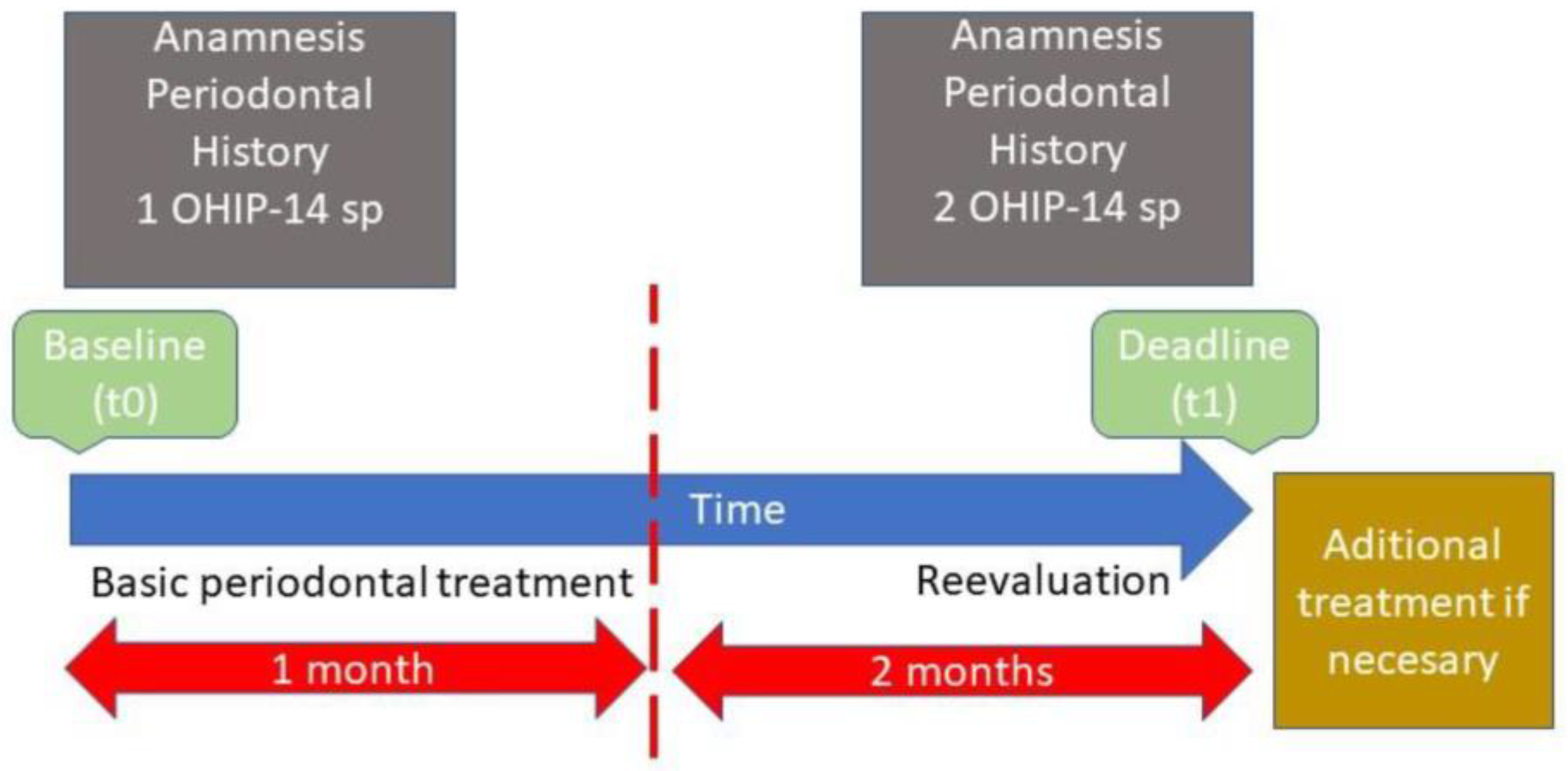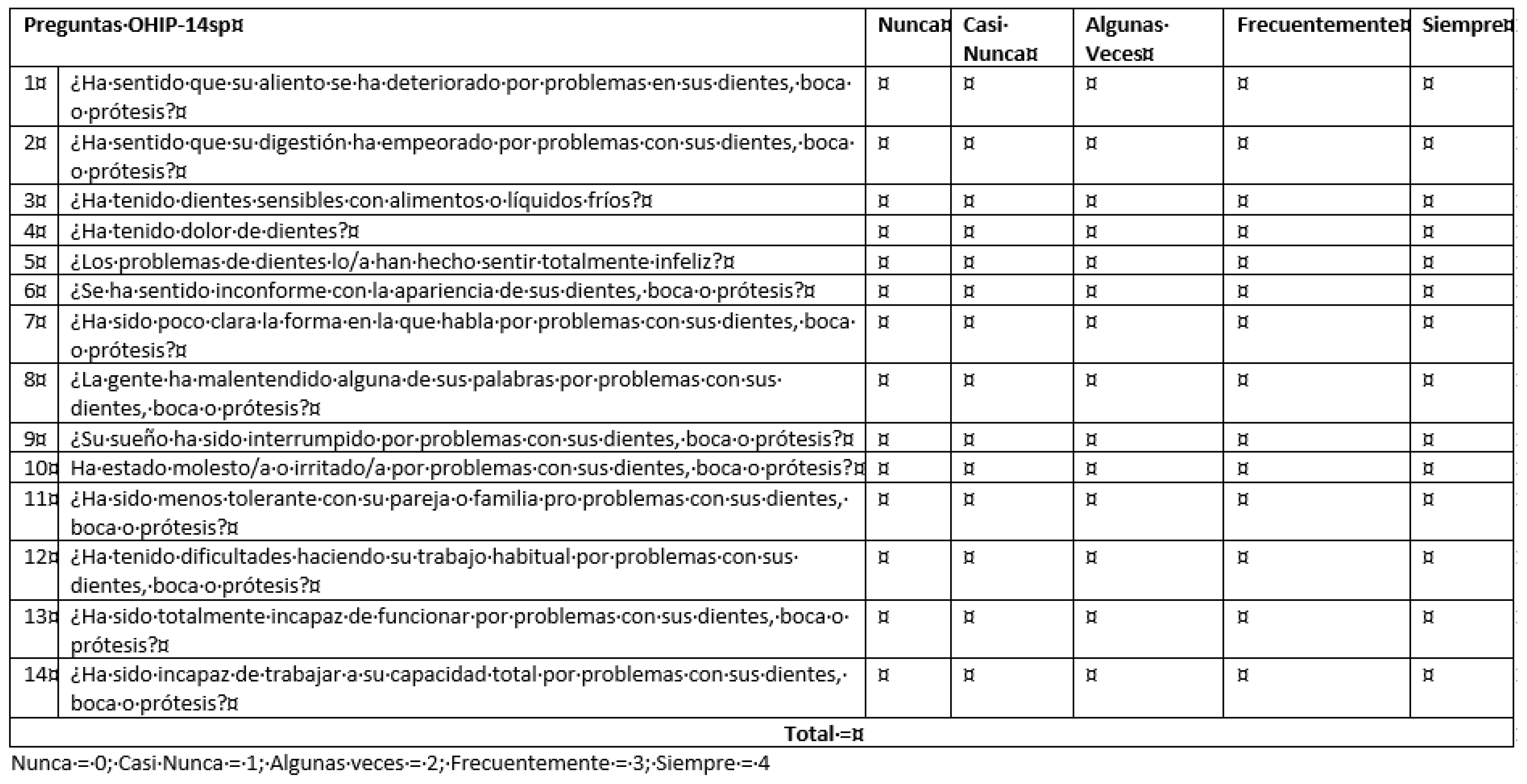Periodontal Disease and Nonsurgical Periodontal Therapy on the OHRQoL of the Patient: A Pilot Study of Case Series
Abstract
1. Introduction
2. Materials and Methods
2.1. Study Population
- Functional limitation (trouble in pronouncing words, worsened sense of taste),
- Handicap (life in general is less satisfying, totally unable to function),
- Psychological disability (difficult to relax, being slightly embarrassed),
- Psychological discomfort (having felt tense, being self-conscious),
- Physical disability (having to interrupt meals, diet has been unsatisfactory),
- Physical pain (uncomfortable eating any foods, painful aching)
- Social disability (irritable with other people, difficulty performing usual jobs).
2.2. Ethical Considerations
2.3. Procedures
2.4. Statistical Analysis
3. Results
Author Contributions
Funding
Institutional Review Board Statement
Informed Consent Statement
Data Availability Statement
Acknowledgments
Conflicts of Interest
References
- Kassebaum, N.J.; Bernabé, E.; Dahiya, M.; Bhandari, B.; Murray, C.J.L.; Marcenes, W. Global burden of severe periodontitis in 1990-2010: A systematic review and meta-regression. J. Dent. Res. 2014, 93, 1045–1053. [Google Scholar] [CrossRef] [PubMed]
- Ng, S.K.S.; Leung, W.K. Oral health-related quality of life and periodontal status. Community Dent. Oral Epidemiol. 2006, 34, 114–122. [Google Scholar] [CrossRef] [PubMed]
- Locker, D.; Allen, F. What do measures of ‘oral health-related quality of life’ measure? Community Dent. Oral Epidemiol. 2007, 35, 401–411. [Google Scholar] [CrossRef]
- Sonnenschein, S.K.; Betzler, C.; Kohnen, R.; Krisam, J.; Kim, T.-S. Oral health-related quality of life in patients under supportive periodontal therapy. Acta Odontol. Scand. 2018, 76, 572–579. [Google Scholar] [CrossRef] [PubMed]
- Montero-Martín, J.; Bravo-Pérez, M.; Albaladejo-Martínez, A.; Hernández-Martín, L.A.; Rosel-Gallardo, E.M. Validation the oral health impact profile (OHIP-14sp) for adults in Spain. Med. Oral Patol. Oral Cir. Bucal. 2009, 14, E44–E50. [Google Scholar]
- Slade, G.D.; Spencer, A.J. Development and evaluation of the oral health impact profile. Community Dent. Health 1994, 11, 3–11. [Google Scholar]
- Wadgave, U.; Khairnar, M.R. Parametric tests for likert scale: For and against. Asian J. Psychiatr. 2016, 24, 67–68. [Google Scholar] [CrossRef]
- John, M.T.; Reissmann, D.R.; Čelebić, A.; Baba, K.; Kende, D.; Larsson, P.; Rener-Sitar, K. Integration of oral health-related quality of life instruments. J. Dent. 2016, 53, 38–43. [Google Scholar] [CrossRef]
- Slade, G.D. Derivation and validation of a short-form oral health impact profile. Community Dent. Oral Epidemiol. 1997, 25, 284–290. [Google Scholar] [CrossRef]
- Theodoridis, C.; Violesti, A.; Nikiforidou, M.; Menexes, G.C.; Vouros, I.D. Short-term impact of non-surgical and surgical periodontal therapy on oral health-related quality of life in a greek population-a prospective cohort study. Dent. J. 2020, 8, 54. [Google Scholar] [CrossRef]
- Caton, J.G.; Armitage, G.; Berglundh, T.; Chapple, I.L.C.; Jepsen, S.; Kornman, K.S.; Mealey, B.L.; Papapanou, P.N.; Sanz, M.; Tonetti, M.S. A new classification scheme for periodontal and peri-implant diseases and conditions—Introduction and key changes from the 1999 classification. J. Clin. Periodontol. 2018, 89, S1–S8. [Google Scholar] [CrossRef]
- Bajwa, A.; Watts, T.L.; Newton, J.T. Health control beliefs and quality of life considerations before and during periodontal treatment. Oral Health Prev. Dent. 2007, 5, 101–104. [Google Scholar]
- Wong, R.M.S.; Ng, S.K.S.; Corbet, E.F.; Keung Leung, W. Non-surgical periodontal therapy improves oral health-related quality of life. J. Clin. Periodontol. 2011, 39, 53–61. [Google Scholar] [CrossRef]
- Locker, D. Measuring oral health: A conceptual framework. Community Dent. Health 1988, 5, 3–18. [Google Scholar]
- Naito, M.; Yuasa, H.; Nomura, Y.; Nakayama, T.; Hamajima, N.; Hanada, N. Oral health status and health-related quality of life: A systematic review. J. Oral Sci. 2006, 48, 1–7. [Google Scholar] [CrossRef]
- Tonetti, M.S.; Fourmousis, I.; Suvan, J.; Cortellini, P.; Bragger, U.; Lang, N.P. Healing, post-operative morbidity and patient perception of outcomes following regenerative therapy of deep intrabony defects. J. Clin. Periodontol. 2004, 31, 1092–1098. [Google Scholar] [CrossRef]
- West, N.X.; Lussi, A.; Seong, J.; Hellwig, E. Dentin hypersensitivity: Pain mechanisms and aetiology of exposed cervical dentin. Clin. Oral Investig. 2013, 17 (Suppl. 1), S9–S19. [Google Scholar] [CrossRef]
- Fukumoto, Y.; Horibe, M.; Inagaki, Y.; Oishi, K.; Tamaki, N.; Ito, H.-O.; Nagata, T. Association of gingival recession and other factors with the presence of dentin hypersensitivity. Odontology 2013, 102, 42–49. [Google Scholar] [CrossRef]
- Habashneh, R.A.; Khader, Y.S.; Salameh, S. Use of the arabic version of oral health impact profile-14 to evaluate the impact of periodontal disease on oral health-related quality of life among Jordanian adults. Int. J. Oral Sci. 2012, 54, 113–120. [Google Scholar] [CrossRef]
- Buset, S.L.; Walter, C.; Friedmann, A.; Weiger, R.; Borgnakke, W.S.; Zitzmann, N.U. Are periodontal diseases really silent? A systematic review of their effect on quality of life. J. Clin. Periodontol. 2016, 43, 333–344. [Google Scholar] [CrossRef]
- Ferreira, M.C.; Dias-Pereira, A.C.; Branco-de-Almeida, L.S.; Martins, C.C.; Paiva, S.M. Impact of periodontal disease on quality of life: A systematic review. J. Clin. Periodontol. Res. 2017, 52, 651–665. [Google Scholar] [CrossRef] [PubMed]
- Shanbhag, S.; Dahiya, M.; Croucher, R. The impact of periodontal therapy on oral health-related quality of life in adults: A systematic review. J. Clin. Periodontol. 2012, 39, 725–735. [Google Scholar] [CrossRef] [PubMed]
- Goel, K.; Baral, D. A comparison of impact of chronic periodontal diseases and nonsurgical periodontal therapy on oral health-related quality of life. Int. J. Dent. 2017, 2017, 9352562. [Google Scholar] [CrossRef] [PubMed]
- Mendez, M.; Angst, P.D.M.; Stadler, A.F.; Oppermann, R.V.; Gomes, S. Impacts of supragingival and subgingival periodontal treatments on oral health-related quality of life. Int. J. Dent. Hyg. 2016, 15, 135–141. [Google Scholar] [CrossRef]
- Botelho, J.; Machado, V.; Proença, L.; Bellini, D.H.; Chambrone, L.; Alcoforado, G.; Mendes, J.J. The impact of nonsurgical periodontal treatment on oral health-related quality of life: A systematic review and meta-analysis. Clin. Oral Investig. 2020, 24, 585–596. [Google Scholar] [CrossRef]
- Tonetti, M.S.; Greenwell, H.; Kornman, K.S. Staging and grading of periodontitis: Framework and proposal of a new classification and case definition. J. Clin. Periodontol. 2018, 45, S149–S161. [Google Scholar] [CrossRef]
- Goergen, J.; Albandar, J.M.; Oppermann, R.V.; Rösing, C.K.; Susin, C.; Haas, A.N. Periodontitis stage and grade are associated with poor oral-health-related quality of life: Findings from the cohort study. J. Clin. Periodontol. 2021, 48, 1333–1343. [Google Scholar] [CrossRef]
- Karaaslan, F.; Dikilitaş, A. The association between stage-grade of periodontitis and sleep quality and oral health–related quality of life. J. Clin. Periodontol. 2019, 90, 1133–1141. [Google Scholar] [CrossRef]
- Ustaoğlu, G.; Bulut, D.G.; Gümüş, K.Ç.; Ankarali, H. Evaluation of the effects of different forms of periodontal diseases on quality of life with OHIP-14 and SF-36 questionnaires: A cross-sectional study. Int. J. Dent. Hyg. 2019, 17, 343–349. [Google Scholar] [CrossRef]


| Variables | Mean (SD) | Mean (SD) | Matched Differences | ||||
|---|---|---|---|---|---|---|---|
| OHIP-14sp1 | OHIP-14sp2 | Mean | SE | 95% CI | p | ||
| Functional limitation | 2.13 (1.76) | 1.55 (1.71) | 0.57 | 0.12 | 0.32 | 0.83 | ** |
| Physical pain | 3.61 (1.89) | 3.09 (1.70) | 0.52 | 0.17 | 0.18 | 0.87 | ** |
| Psychological discomfort | 2.73 (2.51) | 2.25 (2.49) | 0.47 | 0.16 | 0.14 | 0.80 | ** |
| Physical disability | 0.84 (1.58) | 0.60 (1.31) | 0.23 | 0.11 | 0.01 | 0.46 | * |
| Psychological disability | 1.43 (1.82) | 1.09 (1.65) | 0.33 | 0.13 | 0.06 | 0.61 | * |
| Social disability | 0.64 (1.20) | 0.45 (0.99) | 0.18 | 0.08 | 0.02 | 0.34 | * |
| Handicap | 0.44 (1.11) | 0.34 (1.02) | 0.10 | 0.06 | −0.03 | 0.23 | 0.13 |
| Total OHIP-14sp | 11.70 (8.38) | 9.38 (8.16) | 2.32 | 0.39 | 1.54 | 3.10 | ** |
| Dependent Variables | Grade | Grade | DM | SE | 95% CI | p | |
|---|---|---|---|---|---|---|---|
| Physical pain 2 | A | B | −0.943 | 0.067 | −1.95 | −0.07 | 0.067 |
| C | −1.401 | 0.034 | −2.69 | −0.11 | 0.034 * | ||
| Dependent Variables | Stage | Stage | DM | SE | 95% CI | p | |
|---|---|---|---|---|---|---|---|
| Psychological discomfort1 (Pretreatment) | III | IV | −1.55 | 0.71 | −2.97 | −0.14 | * |
| Physical disability1 (Pretreatment) | IV | I | 1.27 | 0.62 | 0.03 | 2,53 | * |
| II | 1.45 | 0.53 | 0.38 | 2.53 | ** | ||
| III | 0.94 | 0.44 | 0.06 | 1.83 | * | ||
| Psychological disability1 (Pretreatment) | II | III | −1.39 | 0.54 | −2.49 | −0.30 | * |
| Social disability1 (Pretreatment) | IV | I | 1.11 | 0.47 | 0.16 | 2.06 | * |
| II | 1.13 | 0.40 | 0.32 | 1.95 | ** | ||
| III | 0.72 | 0.33 | 0.05 | 1.39 | * | ||
| Handicap1 (Pretreatment) | IV | I | 0.94 | 0.44 | 0.06 | 1.82 | * |
| II | 0.87 | 0.37 | 0.12 | 1.63 | * | ||
| Psychological discomfort2 (Post-treatment) | IV | I | 2.00 | 1.00 | 0.01 | 3.99 | * |
| III | 1.55 | 0.70 | 0.15 | 2.97 | * | ||
| Handicap2 (Post-treatment) | IV | II | 0.72 | 0.35 | 0.02 | 1.42 | * |
| Total OHIP-14sp1 (Pretreatment) | II | IV | −6.18 | 2.89 | −11.95 | −0.42 | * |
Disclaimer/Publisher’s Note: The statements, opinions and data contained in all publications are solely those of the individual author(s) and contributor(s) and not of MDPI and/or the editor(s). MDPI and/or the editor(s) disclaim responsibility for any injury to people or property resulting from any ideas, methods, instructions or products referred to in the content. |
© 2023 by the authors. Licensee MDPI, Basel, Switzerland. This article is an open access article distributed under the terms and conditions of the Creative Commons Attribution (CC BY) license (https://creativecommons.org/licenses/by/4.0/).
Share and Cite
Moya-Villaescusa, M.J.; Sánchez-Pérez, A.; Esparza-Marín, J.; Jornet-García, A.; Montoya-Carralero, J.M. Periodontal Disease and Nonsurgical Periodontal Therapy on the OHRQoL of the Patient: A Pilot Study of Case Series. Dent. J. 2023, 11, 94. https://doi.org/10.3390/dj11040094
Moya-Villaescusa MJ, Sánchez-Pérez A, Esparza-Marín J, Jornet-García A, Montoya-Carralero JM. Periodontal Disease and Nonsurgical Periodontal Therapy on the OHRQoL of the Patient: A Pilot Study of Case Series. Dentistry Journal. 2023; 11(4):94. https://doi.org/10.3390/dj11040094
Chicago/Turabian StyleMoya-Villaescusa, María José, Arturo Sánchez-Pérez, Jesús Esparza-Marín, Alfonso Jornet-García, and José María Montoya-Carralero. 2023. "Periodontal Disease and Nonsurgical Periodontal Therapy on the OHRQoL of the Patient: A Pilot Study of Case Series" Dentistry Journal 11, no. 4: 94. https://doi.org/10.3390/dj11040094
APA StyleMoya-Villaescusa, M. J., Sánchez-Pérez, A., Esparza-Marín, J., Jornet-García, A., & Montoya-Carralero, J. M. (2023). Periodontal Disease and Nonsurgical Periodontal Therapy on the OHRQoL of the Patient: A Pilot Study of Case Series. Dentistry Journal, 11(4), 94. https://doi.org/10.3390/dj11040094







